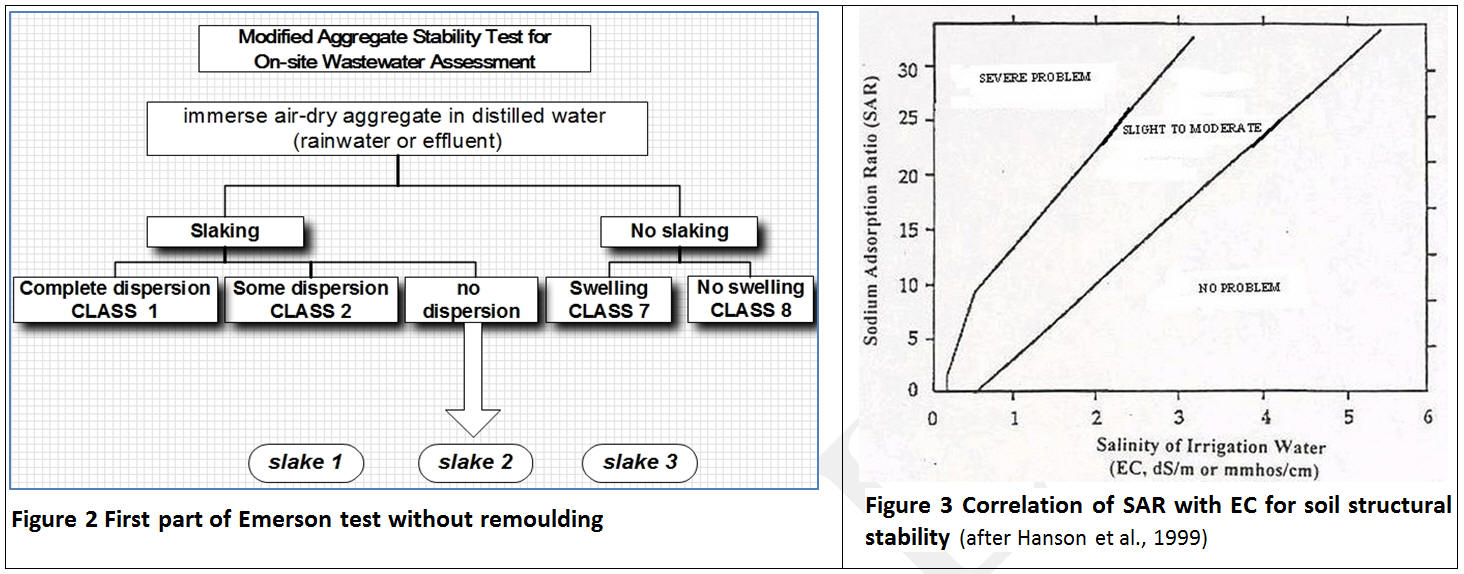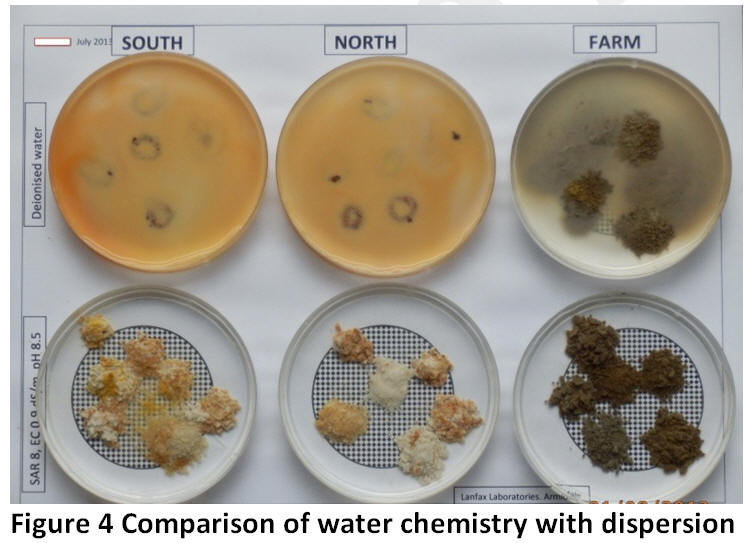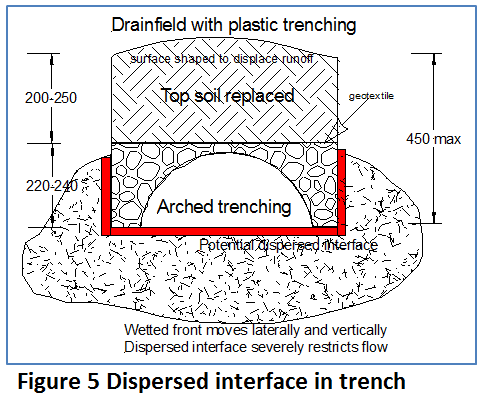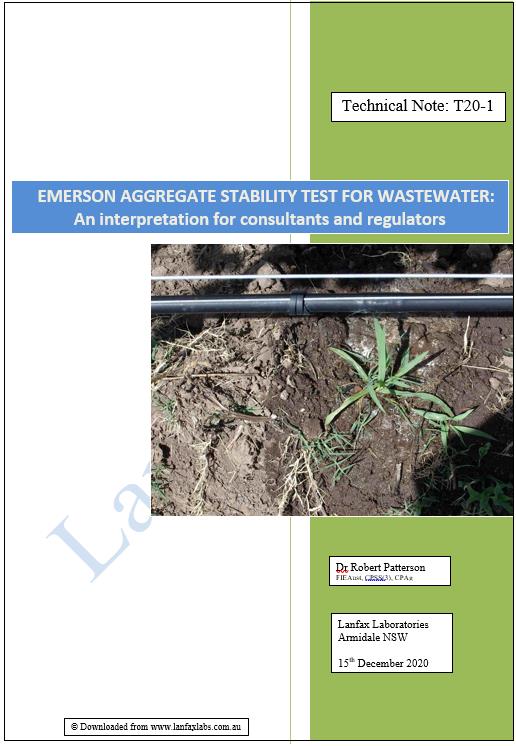Aggregate Stability and Wastewater
Application
Overview
When soil comes in contact with water, the
disruption of the stable soil aggregate may be immediate, subtle (occurs slowly)
or the soil aggregate may be water stable. William Emerson developed a
simple aggregate stability test to assist farmers in understanding the
implication for soil stability before ploughing or cultivation, thus preventing
loss of critical stable soil structure.
The Emerson test is simple: take some small, air dry soil aggregates (each about 3-5 mm in diameter) and place these in a dish of water. After two hours the arrangement of the original aggregates is examined and compared with the original ped. When distilled water is used, the effects can be most dramatic for soils with high sodicity or soils with very low organic matter. Sodic soils (high in sodium relative to calcium and magnesium) (see previous page: SODIUM ADSORPTION RATIO) may also disperse into individual clay particles and form a cloud around the slaked soil.
While this form of the test may be adequate for farming systems and soil stability assessment for highly disrupted soils, such as those ploughed when soil moisture levels are higher than desirable, the test for wastewater or effluent needs to consider the quality of the water used for the test. While clean water may mimic rainwater, the chemicals in domestic wastewater or effluent provide an entirely different outcome when used for the Emerson test. In many instances, soil aggregates, that would disperse in clean water, are more stable in domestic wastewater or effluent because of an ionic effect - the effect of the water having a higher electrical conductivity due to dissolved solids.
Clean water, whatever that means, is not a suitable testing liquid for soil dispersion under domestic wastewater systems. If by clean water one means rainwater, then that distinction should be made. If one means tap water from a municipal supply, then one should state what municipal supply one means, since municipal water varies considerably from town to town because of geology of groundwater and surface catchments. Even so, when one talks about greywater, one should be very clear what chemistry of inputs and original water are considered. The variability may be high, hence the reaction with soils may be different.
A reminder: wastewater is simply the untreated water from a dwelling, or raw water that arrives at a sewage treatment plant; effluent is the liquid after it has undergone some treatment, varying from primary, secondary or tertiary treatment, as explained under the SEPTIC TANK heading.
As discussed under the various pages in "laundry products", the addition of chemicals during use of water within the home can significant change the effects of that water on the land application area, even after primary or secondary treatment. Many of the chemicals pass through the treatment system unaffected and may seriously damage the structural stability of the soil and its potential permeability.
A reminder: Infiltration is simply the movement of water into soil - throw a bucket of water on the soil and measure how quickly or slowly is dissipates into the soil. Permeability is a measure of the rate at which water moves through the soil, passing though the larger drainage pores and pulled through the very small capillaries. The two terms are not the same and cannot be used interchangeably. For most of our discussion on wastewater or effluent application to soils, we are more interested in the permeability.
The following information is available as a printable document
click here for Technical Note T20-1 Emerson Aggregate Stability Test for Wastewater
TABLE OF CONTENTS
1. Introduction
2. Dispersibility Testing
3. Modified Aggregate Test for Wastewater Assessment
4. Assessment of Performance using Modified Test
5. Reporting Modified Emerson Test Results
6. Interpretation by Consultants and Regulators
7. References
EMERSON AGGREGATE STABILITY TEST FOR WASTEWATER
1. Introduction
The Emerson aggregate test (Emerson, 1967) was designed to help farmers classify the structural stability of a soil aggregate (ped) under rainfall, and indicate the effects of physical manipulation (cultivation) on soil at an elevated moisture level. Structural stability is essential for macroporosity, the pathway of water movement through soil (drainage), while microporosity functions by capillary action, holding plant available water. Both these processes are important for effluent disposal into the soil profile. Dispersed soil colloids that move with drainage water have the potential to block these pores and reduce hydraulic conductivity. Slaking of a soil ped is mostly due to low organic matter and is not a detriment to effective effluent dispersal, although it may lead to some temporary hard setting on a bare surface.
2. Dispersibility Testing
AS/NZS 1547:2012 On-site Domestic Wastewater Management refers to the Emerson Aggregate Test (page 109). Firstly, the test method requires the ‘three undisturbed aggregates …. are carefully immersed in a beaker of distilled water’. The Standard fails to indicate that the aggregates (peds) have to be air-dry. Secondly, distilled water is not indicative of the actual chemistry of effluent. Those instructions are wrong with respect to the impact of effluent on the soil, or soil in effluent, and provide no evidence of performance under actual in-field conditions. Emerson (1967) indicated a test period of two hours, not 24 hours as stated in AS/NZS1457:2012. In most cases the evidence is clear within minutes.
Thirdly, because the soil in the land application area is not manipulated (cultivated) when wet, the ‘remould’ and subsequent parts of the Emerson test (Classes 3-6) are irrelevant for effluent assessment. Irrespective, a remoulded bolus (ball) should not be taken from the bolus used to determine field texture because excess manipulation plus salt from the operator’s hand unduly influence the performance of the remoulded sample. Such actions, as suggested in AS/NZS 1547, are contrary to AS 1289.3.8.1-1997 where the remoulded ped is manipulated with a plastic spatula at a moisture content consistent with that required for determining plasticity (plastic limit test), as required by Emerson. The two standards are contradictory - which one correctly follows Emerson's publication?.
The NSW Environment and Health Protection Guidelines (1998) (page 73) refer to ‘the Modified Emerson Aggregate Test’ but fails to nominate what has been modified or indicate the need for air-dry peds. The method does require the use of a solution with a sodium adsorption ratio (SAR) of 5 but does not indicate the salinity level (as electrical conductivity (EC)) of this trial solution. One could mix an SAR 5 solution using sea water, but that would not mimic domestic effluent. But if you don’t know, what do you do? SAR is a property of the liquid, not the solid (soil).
The NSW Environmental Guidelines: Use of effluent by irrigation (DEC, 2004, page 12) states that “Stable aggregates will usually have an Emerson Aggregate Test (EAT) of between 4 and 7. An EAT of 8 means that the soil is so stable that it cannot be penetrated by plant roots”. What nonsense! Soil peds formed in soils other than high shrink/swell montmorillonite clays (expanding clays) or soils high in organic matter can be quite stable under the Emerson test in clean water. The small peds used in the Emerson test are likely to be stable aggregates within a well-structured horizon where exist many pathways for water penetration and root expansion. Further, the document (Table 2.2, page 14) states that Classes 4-8 have ‘nil to slight’ limitation for effluent irrigation systems, moderate for Classes 2 and 3, and severe for Class 1 with the stated reason ‘poor structure’ when the reasons surely the EAT indicates structural stability in the effluent and not soil structure. The document makes no mention of the interpretation of ‘slaking’ in relation to structural stability.
The VicEPA Code of Practice Onsite Wastewater Management (891.3) defers testing for dispersion without qualification, presumably to AS/NZS 1547:2012. The VicEPA Land Capability Assessment for Onsite Domestic Wastewater Management (746.1) does not indicate any requirements for the Emerson Test and seems confused between dispersion and slaking (page 8); the former a property of the colloids and the latter related to organic glues.
The paper by van de Graaff and Patterson (2001) suggests that the interplay of sodium, measured as SAR, and the electrolyte concentration (as EC) in the application water, together with the ESP of the soil, can be used to assess the likely risk of dispersion from the irrigation water on the soil. It is important that the Emerson’s test is performed with water of a similar EC and SAR as the effluent to be irrigated to the soil. One must understand that additions of lime and/or gypsum may be used to counter the effect of high sodium; an explanation is beyond the scope of this paper.
To accurately gauge the effect of effluent on soil structural stability, the test liquid requires similar EC and SAR as the effluent discharged from a septic tank, aerated wastewater treatment system, wetland or other process.
3. Modified Aggregate Test for Wastewater Assessment
The only results of interest in wastewater management are those shown in Figure 1. The method requires 3-5 air-dry soil peds of about 5 mm be immersed in a solution having SAR 5 and EC about 1 dS/m to mimic domestic effluent (Patterson, 1994). The peds are examined after two hours and the appearance of the peds is compared with Figure 1. Sample dishes should be covered to avoid disturbance by air currents. Note that, as discussed previously, there is no requirement for remoulding because the land application area for effluent dispersal is not physically altered when wet.

Note: The layout of Figure 1 matches the set out in Figure 2.
A typical quality domestic effluent has an EC of about 1 dS/m and an SAR of about 5. Both these properties are critical to soil structural stability as shown by Figure 3, where high SAR requires a high EC (high salinity) to maintain soil structural stability, that is, the high salinity (as EC) overcomes the effects of high sodicity (as SAR).
The most severe influence to a soil ped is where the liquid has a very low EC, such as distilled water or rain.
SAR is measured on the effluent and is a ratio of the concentration of sodium ions to the combined concentration of the calcium and magnesium ions. The formula is a little more complicated than a straight ratio but sufficient for understanding at this stage. The higher the sodium relative to calcium plus magnesium, the greater the potential for a decrease in structural stability of the peds in water, as shown in Figure 3.
Therefore, testing air-dry soil peds with an artificial effluent provides a better understanding of the influence of the effluent upon the soil than testing with distilled water. The same can be said for testing the soil in any irrigation area with a water of similar quality to that being irrigated, definitely not with distilled/deionised water.

The proportion of sodium ions, in the
soil, to the sum of all the exchangeable cations (Ca2+, Mg2+,
Na+, K+, H+ and Al3+) is called the
exchangeable sodium percentage (ESP). Again, the higher the sodium relative to
all the exchangeable cations gives a greater propensity for the soil to
disperse, particularly in distilled water (rainwater). Sodicity can be assessed
from soil chemical analysis – reported as ESP. Values greater than ESP 6% may
need amelioration. We ameliorate a soil by increasing calcium
and/or magnesium, as limestone (Ca2+), gypsum (Ca2+), or
dolomite (Ca2+/Mg2+).
We ameliorate a soil by increasing calcium
and/or magnesium, as limestone (Ca2+), gypsum (Ca2+), or
dolomite (Ca2+/Mg2+).
The behaviour of the peds in clean water is important where an understanding of the effects of rain on surface soil structural stability is required, such as rain on soil irrigated with greywater, septic tank effluent or coal seam gas water. Such testing would require alternate treatment with effluent and distilled water under controlled conditions.
The modified Emerson test results include Classes 1, 2, 7 and 8 and the degree of slaking for others, as shown in Figure 2. Peds that only slake may be classed as *3/6, slake 1, 2 or 3. The determination of classes 3 to 6 is irrelevant where the soil is not 'worked' for agricultural plantings. In effluent irrigation area, cultivating the soil after application of effluent is not a common practice and effluent percolating into the sides and bottom of trenches is entering natural soil.
A comparison of peds of three soils in deionised water and irrigation water (SAR 8, EC 0.9 dS/m) is shown in Figure 4. Note that in deionised water all three soils disperse, South and North as Class 1 and Farm as Class 2.
In irrigation water, the soils only slake, showing that the problem of dispersibility is overcome because of the chemistry of the irrigation water.
Figure 4 shows that the difference
between testing with deionised (distilled) water and effluent can be quite
pronounced.
Using deionised (distilled) water may give a false performance rating, raising
issues that will not exist under field conditions.
4. Assessment of Performance using Modified Test
Classes 1 and 2 indicate that the soil colloids are easily disrupted (disperse) with a complete loss of stability, as reflected by the cloud of colloids (individual charged clay particles). The cause may be related to sodic properties (high ESP), or to water with very low EC. These soils may be remediated using lime or gypsum that increases the EC of the effluent, as indicated in Figure 3. Dispersion at the soil interface in a trench, as shown in Figure 5, presents practical difficulties with rehabilitating the interface to encourage passage of effluent from the trench into the soil.
When dispersed particles (clay colloids) move through the soil profile with drainage water, the colloids may block the small capillary passages with a resulting loss of permeability, as in any filter system. As the soil dries, the more dense soil sets as a crust, further limiting the infiltration of water at the surface or the permeability through the soil at depth.
Dispersion at the interface of a soil
trench only needs to be a few millimetres thick to block soil pores with the
resulting loss of permeability. Such blockage is difficult to reverse with
chemicals and a new trench may be required.
Unlike a biofilm that may be removed using
hydrogen peroxide (H2O2), soil particles are minerals that
are difficult to disrupt chemically. 
Slaking soils result from low organic content, insufficient organic glues to hold individual soil particles together, hence when placed in water the escaping air easily disrupts the mineral particles and the ped falls apart, but does not separate into individual colloids. Most Australian sub-soils slake to some extent. The addition of organic matter may resolve the slaking issues. Slaking soils pose very minor stability limitations for effluent disposal as the soil at the trench interface never really dries out completely..
Soils that do not disperse or slake are usually well endowed with organics and are able to maintain their original shape when placed in effluent, they are reported as 'water stable'. Many surface soils are water stable. Class 7 soils usually swell because of their mineralogy. Classes 7 & 8 have no stability limitations for effluent dispersal.
Sandy soils, such as sands, loamy sands and clayey sands mostly have insufficient clay to form peds, hence unlikely to disperse in water or effluent. The soil pores are usually too large to be easily blocked by moving colloids. Any peds that are available will usually slake because of insufficient organic glues holding the soil minerals as a ped.
All soils, over time, may be influenced by effluent chemistry and their susceptibility to disperse in effluent slowly increases. This effect is not only a function of the effluent, particularly SAR and EC effects, but also the soil ESP.
5. Reporting Modified Emerson Test Results
The modified Emerson test can be reported and interpreted, with respect to domestic wastewater application as:
Class 1 - severe dispersion, maybe related to high sodicity which forces the clay particles to separate in water. Amelioration with lime or gypsum may improve structural stability by increasing EC. Class 1 soils have a major limitation to wastewater application because of reduced permeability and potential to compact as the pores block and the soil dries.
Class 2 – moderate dispersion, maybe related to high sodicity. Amelioration with calcium and/or magnesium may be effective by increasing EC and reducing ESP. Without amelioration, this class has a major limitation to wastewater application as for Class 1, particularly for sodium rich domestic effluent.
Classes 3-6 –remoulding, and 1:5 soil:water suspension tests are irrelevant to the behaviour of soils in wastewater assessment, but one can report the test results with degree of slaking as:
Slake 1 (slight), slake 2 (moderate) or slake 3 (completely slumped) (as shown in Figure 1). Slake 1, 2 or 3 – no limitation to wastewater application, but may benefit from additional organic matter for surface irrigated soils.
As a shorthand, this category of slaking soils may be reported as *3/6, slake 1 indicating that the class may be within the group of classes 3 to 6, but the general behaviour of the ped in the synthetic effluent (SAR 5, EC 1 dS/m) is that the ped slakes slightly. Replace slaking with grade as 2 or 3 as appropriate.
Classes 7 and 8 – these soils are water stable, but may swell (Class 7) or retain original size and shape (Class 8). Neither of these classes is a limitation to wastewater application as they do not change their physical relationship between wetting and drying. The soil peds do not collapse to block the larger pores between structural units.
6. Interpretation by Consultants and Regulators
Assessment of the Emerson test results is reasonably clear. Sandy soils have insufficient clay to strongly bind soil mineral particles into peds. It would be inaccurate for a sand to be rated on the Emerson scale.
Dispersible soils have major limitations and the consultant/regulator should note the need for amelioration or special treatment of the soil to overcome the potential for reduced permeability and compaction of Class 1 and Class 2 soils. The test procedure using clean water is of no value when comparing to the behaviour with effluent.
Soils that slake but do not disperse (Classes 3-6) and soils that neither slake nor disperse (Classes 7 & 8) have no limitation based on modified Emerson’s test.
7. References
Department of Local Government (1998) NSW Environment and Health Protection Guidelines: On-site sewage management for single households NSW Dept Local Govt, NSW Environ. Protection Authority, NSW Health, NSW Land & Water Conservation and Dept Urban Affairs & Planning.
Emerson, W.W. (1967) A classification of soil aggregates based on their coherence in water. Aust. J. Soil Res., 1967, 5, 47-57
Hanson, B., S.R. Grattan and A. Fulton. 1999. "Agricultural Salinity and Drainage." University of California Irrigation Program. Uni.California, Davis.
Patterson, R.A. (1994) On-site treatment and disposal of septic tank effluent. Ph.D. thesis. University of New England, Armidale.
Standards Australia & Standards New Zealand (2012) AS/NZS 1547:2012 On-site Domestic Wastewater Management. Standards Australia, Lidcombe and Standards New Zealand, Wellington.
Standards Australia (1997) AS1289.3.8.1-1997 Soil classification tests – Dispersion – Determination of Emerson class number of a soil. Standards Australia, Lidcombe.
van de Graaff, R and Patterson, R.A. (2001) Explaining the Mysteries of Salinity, Sodicity, SAR and ESP in On-site Practice in Proceedings of On-site ‘01 Conference: Advancing On-site Wastewater Systems by R.A. Patterson & M.J. Jones (Eds). Published by Lanfax Laboratories, Armidale
VicEPA (2013) Code of Practice Onsite Wastewater Management (Publication 891.3) Environment Protection Authority, Melbourne
VicEPA (2003) Land Capability Assessment for Onsite Domestic Wastewater Management (Publication 746.1) Environment Protection Authority, Melb.
